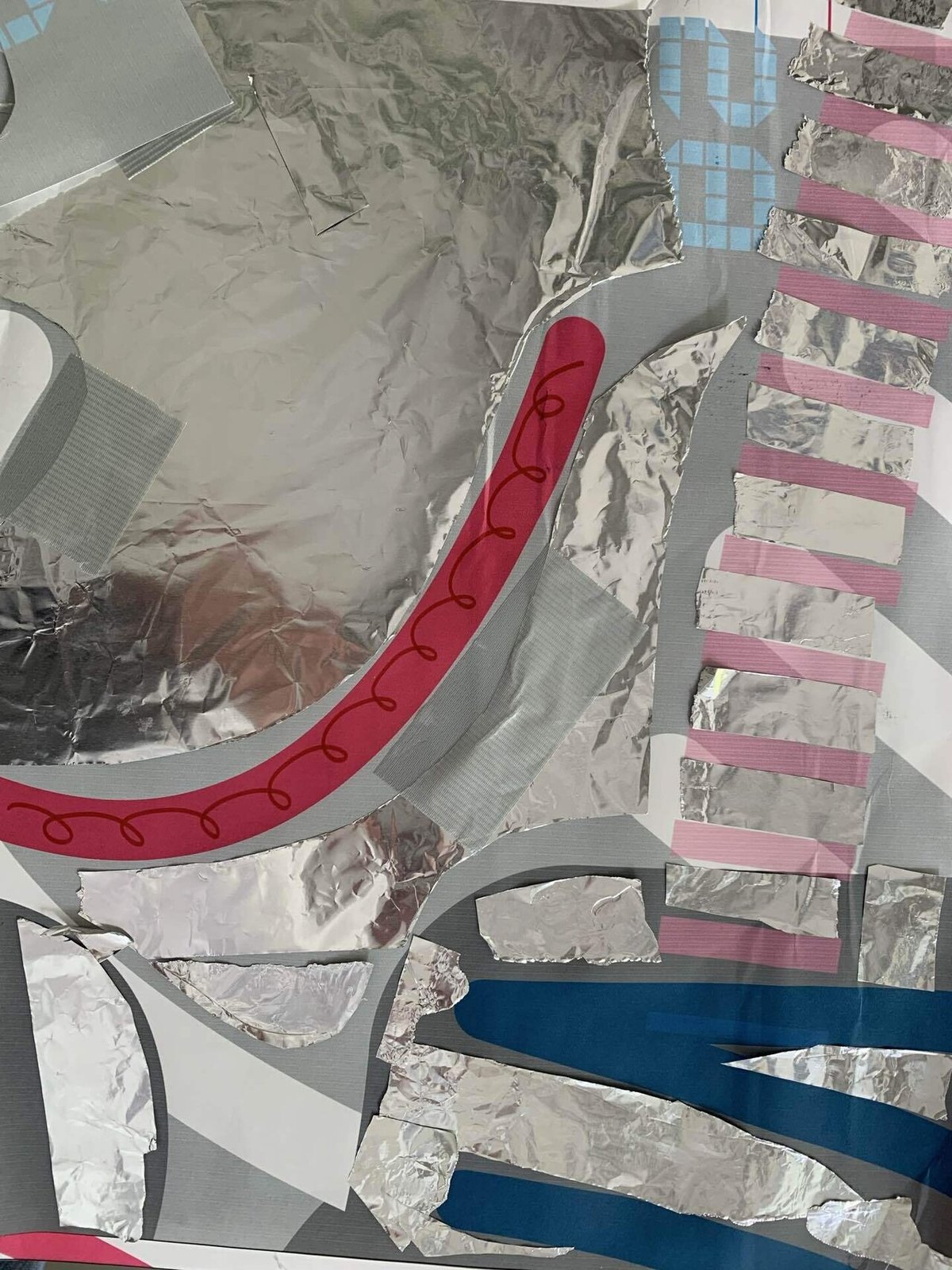
鹿児島市立美術館で「第36回む展」開催中
武蔵野美術大学校友会鹿児島支部の有志による展覧会「む展」が開催中。僕は、確か第22回展から参加しているから、今回で15回目・・・。昨年はコロナ禍で中止になってしまったんだけど、今年は何とか開催できた。来場者も、毎日100名超と、想像よりも多い。やはりみんな、何かを見たい、出かけたいという気持ちが高まっているのだろうか。
さて、自分の作品を解説することにしよう。画像を見ただけではわからないと思うが、A3サイズのラミネート加工した作品を80枚並べてあり、全部で縦横それぞれ3メートル程度の大きさになる。
普段、自分はデジタル作品を描いているから、プリントアウトあるいは印刷されてしまうまでは、大きさという概念はあまりなく作業を進めることになる。しかし展覧会となると、存在感(のようなもの)を作品に持たせなくてはいけない。素の状態は、情報であるから重さは存在しないんだけど、それをわざわざ物質に変換する作業が始まるというわけだ。この考え方は1993年、自分が初めてマックを手に入れた頃からあまり変わっていない。例えば出力したものを二重にして(一枚は透明フィルムなど)、その場でしか見られないものにした展覧会を何度か行った。
今回は、大きさをまず決めた。
・まあ3メートルだからA3サイズがこれくらい必要だなあ
・大きいからゾウでも描くか
その程度のスタートだった。
Adobe illustratorを使って原寸を考慮しながら下絵を描いた。この作業自体は1時間程度で終わったと思う。
それを大判プリンタ EPSON PX7500 でA1ノビのロール紙に出力。それをA3サイズにカットしていく。
カットされた80枚のパーツに、部分的にカッターを入れて穴を開けたり、画用紙や雑誌の切り抜きを貼り付けたりして、生のテクスチャーを加える。
鉛筆やマジックで、その場で思いついた線やカタチを描き加える。

ゾウの体の部分は、アルミホイルを使用して、存在感を高めていく。
画像のような感じになってくる。ここまでやれば、デジタルの出力がベースになっているということが、自分でも気にならなくなってくる。
あ、あと・・・余談だが、ゾウをイメージした時にいつも思い浮かぶ音楽がある、それは1984年に発表された坂本龍一の「音楽図鑑」に収められている「羽の林で」という静かな名曲だ。ここではピーター・バラカンの歌詞を教授(坂本)が朗読するのだが、「千頭のゾウが一瞬でコースを変える」という一節がある。この言葉も、その場で鉛筆で書き込んである。坂本龍一はその後もゾウの社会をテーマにしたアルバム「エレファンティズム」を発表している。
ここからの作業は無心になれる。仕事の場合でも、絵を描き始めてからはほぼ無心状態になれるんだけど、展覧会の場合は自分がクライアントなので失敗や冒険を際限なく行える。トライアンドエラーではなく、エラーアンドエラーで、手作業の跡をそのまま残しておく、そんな感じだ。
80枚、似たような作業を繰り返したあと、全てラミネート加工する。せっかく作ったものをラミネートすることに疑問を感じる人もいると思う。せっかくのテクスチャーが、また平らになってしまうし、質感的にも安っぽく、弱くなる。
自分は、人間の魂の動きが、そのまま絵の具の盛り上がり方や、筆致に投影されている状態がそんなに好きではない。どんな絵画でも、表面は滑らかな方が好きだから、ラミネートすることに抵抗はない。ただ、エコロジーの観点からすると素材的にどうなのか?という指摘は近しい方から受けた。
搬入の日。
作品を車に積み込んで美術館へ。実は搬入の日というのは展覧会当日よりも楽しい場合が多い。参加メンバーとあれこれ語りながら、美術館全体をどう見せるのか工夫しながら配置を決めていく。鹿児島市立美術館の第一室と呼ばれる場所は、映画でいうとオープニングの30分にあたり、どれだけのインパクトで、どんな物語が語られるのか、来場者もワクワクする場所なのである。そんな訳で、大型の油絵作品の場所が設営中に何度も入れ替えられた。
僕の作品は第一室向きではなく、中盤に差し掛かるあたり、第二室に飾られることになった。
脚立に乗って80枚の作品を壁に貼り付けていく。自宅では、もちろん広げた状態を確認できないから、美術館で、初めて自分も全貌を知ることになる。これも普段のイラストレーターの仕事とは異なる部分だ。貼り付け作業が終わって、作品を引いて見る瞬間が一番楽しいかも知れない。
果たして、うまくいったのかどうか?
30点くらいの出来だと思う。
最も惜しまれる点は、ゾウのボディに使ったアルミホイルが思ったよりも光ってくれないことだった。ライティングで何とかなるのかも知れないが、そこはグループ展だ、他者の作品と隣り合わせになっているので、自分だけ光を変えるということは難しい。市立美術館の照明も昭和のセンスで自由度は低い。
「計画」や「新しいアイデア」が作品から空気として放出されているかに拘るタイプだが、来場者には果たしてどう映るのだろうか。
展覧会初日、いろんな方と作品の前で語り合う。これも楽しい時間だ。美術展には敷居が高くてあまりあまり足を運ばないという人も多いと思う。自分がおすすめする鑑賞方法は、作品を上手い下手、良し悪しで判断するのでははなく「何故、作者は時間をかけて(こんな)作品を作り続けているのだろう」という目で対峙することだ。作者と思われる人が近くにいたら話しかけてみるのもいいだろう。「普通はこんなことに時間を割かないよなあ」という視線で見つめると、作者の人生が垣間見えてくると思うのだ。
コロナ禍でリモート開催も検討された今回の「む展」。その下準備的に撮りためてきた各作家のアトリエ訪問の様子などを動画で見ることもできる。作品の近くに掲示してあるQRコードを読み取れば動画が再生される。
是非会場に足を運んでいただきたい!

The 36th Mu Exhibition” is now being held at Kagoshima City Museum of Art.
The Kagoshima branch of the Musashino Art University Alumni Association is currently holding an exhibition called “Mu Exhibition”. I’ve been participating since the 22nd exhibition, so this is my 15th time.... Last year the exhibition was cancelled due to the Corona disaster, but this year we managed to hold it. We had more than 100 visitors every day, which was more than I expected. I guess people are more interested in seeing something and going out.
Now, I’d like to explain my work. You may not be able to tell from just looking at the images, but there are 80 A3 size laminated works lined up in a row, and the total size is about 3 meters each in height and width.
Since I usually draw digitally, I don’t really think about the size of the work until it is printed out or printed. However, when it comes to an exhibition, I have to give the work a sense of existence (or something like that). In its bare state, it is information, so there is no weight to it, but the process of converting it into matter begins. This idea hasn’t changed much since 1993, when I got my first Mac. For example, I have held several exhibitions where I double-printed the output (one on transparent film, etc.) and made it something that could only be seen on the spot.
This time, I decided on the size first.
Well, it’s three meters long, so it should be about A3 size.
It’s big, so I’ll draw an elephant.
That was the starting point.
I drew a rough sketch of the elephant using Adobe illustrator, taking the original size into consideration. I think this work itself was finished in about an hour.
I used a large format printer, EPSON PX7500, to print it out on a roll of A1-size paper. Then I cut it into A3 size.
To add raw texture to the 80 cut pieces, I cut and punched holes in some parts, and pasted cutouts from construction paper and magazines.
With pencils or magic markers, they add lines and shapes that come to mind on the spot.
For the - body part, use aluminum foil to add a sense of presence.
The result is something like the image. Once I've done this much, I don't mind that it's based on a digital output.
From this point on, the work becomes mindless. In the case of an exhibition, since I am the client, I can make mistakes and have adventures without limit. It's not trialand-error, it's error-and-error, leaving the traces of manual labor intact.
Oh, and as a side note, there is a piece of music that always comes to mind when I think of elephants, a quiet masterpiece called "Hane - No - Hayashi - De" from Ryuichi Sakamoto's "Ongaku Zukan" published in 1984.Here, the professor (Sakamoto) recites Peter Barakan's lyrics, and there is a passage that says, "A thousand elephants changing course in an instant. These words were also written in pencil on the spot. Ryuichi Sakamoto has since released another album, "Elephantism," on the theme of elephant society.
After repeating a similar process for 80 sheets, I laminated them all. Some people may wonder why I laminate my work. Some people may have doubts about laminating something that has been so well made, as it flattens out the texture and makes it look cheap and weak.
I don't like it when the movement of the human soul is projected directly onto the paint and brushstrokes. I like the surface of any painting to be smooth, so I am not opposed to lamination. However, some people close to me have pointed out that from an ecological point of view, what is the point of the material? I have been asked by someone close to me.
I'm not sure if I did a good job.
I'd give it about 30 points.
The most regrettable point was that the aluminum foil used for the elephant's body did not shine as much as I expected. It might have been possible to do something with the lighting, but this was a group exhibition, and I was standing next to other people's works, so it was difficult for me to change the light. The lighting in the municipal museum is also very Showa-era and not very flexible.
I am the type of person who is concerned with whether or not "plans" and "new ideas" are being released from the works as air, but I wonder how the visitors will perceive them when they are focused on whether or not they are visible.
On the first day of the exhibition, I talked with various people in front of the works. This is also a fun time. There are many people who don't often visit art exhibitions because they feel intimidated by them. What I recommend is not to judge a work of art by its quality, but to confront it with the question, "Why did the artist take the time to create such a work? If you see someone nearby who you think is the author, you can talk to them. If you look at the work with an eye that says, "Normally, I wouldn't take the time to do this," you will get a glimpse of the artist's life.
This year's exhibition also features videos of each artist's studio visits. If you read the QR codes posted near the works, you will be able to watch the videos.
This year's "Mu Exhibition" was considered to be held remotely at the Corona Peril.
I hope you will visit the venue!
この記事が気に入ったらサポートをしてみませんか?
